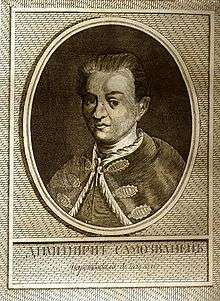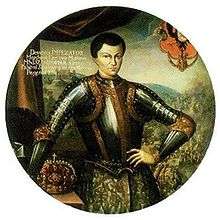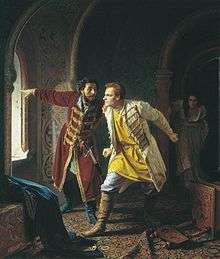False Dmitry I
| Dmitry I | |||||
|---|---|---|---|---|---|
 | |||||
| Tsar and Emperor of All Russia | |||||
| Reign | 10 June 1605 – 17 May 1606 | ||||
| Coronation | 21 July 1605 | ||||
| Predecessor | Feodor II | ||||
| Successor | Vasili IV | ||||
| Born |
19 October 1582 Unknown | ||||
| Died |
17 May 1606 Moscow, Russia | ||||
| Spouse | Marina Mniszech | ||||
| |||||
| Dynasty | Rurik (claimed) | ||||
| Father | Unknown | ||||
| Mother | Unknown | ||||
| Signature |
 | ||||
Dmitry I (Russian: Димитрий, tr. Dmitrii)[1] (historically known as Pseudo-Demetrius I) was the Tsar of Russia from 10 June 1605 until his death on 17 May 1606 under the name of Dimitriy Ivanovich (Russian: Дмитрий Иванович). He is sometimes referred to as False Dmitry I. According to historian Chester L. Dunning, Dmitry was "the only Tsar ever raised to the throne by means of a military campaign and popular uprisings".[2]
He was the first, and most successful, of three "impostors" (самозванцы (sing.: самозванец), samozvanets) who claimed during the Time of Troubles to be the youngest son of Ivan the Terrible, tsarevich Dmitry Ivanovich, who had supposedly escaped a 1591 assassination attempt. It is generally believed that the real Dmitry died in Uglich, and that this Dmitry's name was actually Grigoriy Otrepyev, although this is far from certain.
Background
Dmitry I entered history circa 1600, after making a positive impression on Patriarch Job of Moscow with his learning and assurance. Upon hearing of this, Tsar Boris Godunov ordered the young man to be seized and examined, whereupon Dmitry fled to Prince Constantine Ostrogski at Ostroh, of the Polish–Lithuanian Commonwealth, and subsequently entered the service of the Wisniowieckis, a polonized Ruthenian family. Two family members in particular, the princes Adam and Michał Wiśniowiecki, were intrigued by the stories Dmitry told of whom he purported to be, as it gave the Poles real opportunity to capitalize on the political rancor rising in Moscow.
There were rumors that Dmitry was an illegitimate son of the Polish king, Stefan Batory, who had reigned from 1575 to 1586; according to a later tale, Dmitry blurted out that identity when once slapped by a violent master. Dmitry's own story was that the Tsar Ivan's widow his mother, anticipating Boris Godunov's assassination attempt, had given the young tsarevich into the care of a doctor, who placed him in various Russian monasteries through the years. After the doctor's death, Dmitry had then fled to Poland, working there as a teacher for a brief time, before being accepted into the service of the Wisniowieckis. Several of those who had known Ivan IV claimed later that Dmitry did indeed resemble the young tsarevich; further, the young man also displayed aristocratic tendencies, such as horsemanship and literacy, and was fluent in Russian, Polish, and French.
However, regardless of whether or not Dmitry's tale was authentic, the Wiśniowiecki brothers, along with Samuel Tyszkiewicz, Jan Sapieha, Roman Różyński, and several other Polish noblemen soon agreed to fully back the man, and his claim, against Tsar Boris Godunov. In March 1604, Dmitry visited the royal court of Sigismund III Vasa in Kraków. The king provisionally supported him, but gave no promise of military aid to help ease the young man's path to the throne. To attract the support of powerful Jesuits in lieu of the king outright stating anything, Dmitry publicly converted to Roman Catholicism on 17 April 1604, thus convincing papal nuncio Claudio Rangoni to also back up the young Russian's claim.
During his time at court, Dmitry met Marina Mniszech, daughter of the Polish nobleman Jerzy Mniszech. Dmitry and Marina fell in love; asking her father for her hand, the young man was promised it in return for granting the Mniszechs full rights to the Russian towns of Pskov, Novgorod, Smolensk, and Novhorod-Siverskyi upon his ascension.
Way to the Russian throne

When Boris Godunov received word of Dmitry's Polish support, he spread claims of the younger man being just a runaway monk called Grigory Otrepyev (born Yuri Otrepyev, Grigory being the name given at the monastery), although on what information these claims were based is unproven. Regardless, the tsar's public support soon began to wane, especially as Dmitry's loyalists spread counter-rumors. Several Russian boyars also pledged themselves to Dmitry, thus giving them a "legitimate" reason not to pay taxes to Tsar Boris.
Dmitry, having now gained the full support of the Polish Commonwealth, formed a small army of approximately 3,500 soldiers from various private forces. With these men, he advanced on Russia in March 1605. Godunov's many enemies, including the southern Cossacks, joined Dmitry's army on the long march to Moscow. Thus combined, these forces fought two engagements with reluctant Russian soldiers; winning the first, they captured Chernigov (modern Chernihiv), Putivl (Putyvl), Sevsk, and Kursk, but they badly lost the second battle, almost to the point of disintegrating. The young man's cause was only saved when news of the sudden death of Boris Godunov on 13 April 1605 reached his troops in the aftermath.
With the unpopular tsar dead, the last impediment to Dmitry's progress had been swept away; the victorious Russian troops defected to Dmitry's side, followed soon by others, swelling the Polish ranks as they marched further in. Finally, on 1 June, the disaffected boyars of Moscow staged a palace coup, imprisoning newly crowned tsar Feodor II and his mother, the widow of Boris Godunov.
On 20 June, Dmitry made his triumphal entry into Moscow, and on 21 July, he was crowned tsar by a new Muscovite Patriarch of his own choosing, the Greek Patriarch Ignatius.
Reign


The new tsar moved to consolidate his power by visiting the tomb of Tsar Ivan, and the convent of his widow Maria Nagaya, who accepted him as her son and "confirmed" his story. The Godunovs, including Tsar Feodor and his mother, were executed, with the exception of Tsarevna Xenia, whom Dmitry took as his royal concubine for five months. In contrast to Godunov's policies, many of the noble families Tsar Boris had exiled – such as the Shuiskys, Golitsins and Romanovs – were granted the pardon of Tsar Dmitry and allowed to return to Moscow. Feodor Romanov, sire of the future imperial dynasty, was soon appointed as metropolitan of Rostov; old patriarch Job, who did not recognize the new tsar, was sent into exile.
Dmitry planned to introduce a series of political and economical reforms. He restored Yuri's Day, the day when serfs were allowed to move to another lord, to ease the conditions of peasantry. His favorite at the Russian court, the 18-year-old Prince Ivan Khvorostinin, is considered by historians to be one of Russia's first Westernizers.[3]
In foreign policy, Dmitry sought an alliance with his sponsor, the Polish Commonwealth, and the Papal States. He planned for war against the Ottoman Empire, ordering the mass production of firearms to serve in the conflict. In his correspondence, he referred to himself as "Emperor of Russia" a century before Tsar Peter I used the title, though this was not recognized at the time. Dmitry's royal depictions featured him clean-shaven, with slicked-back dark hair; an unusual look for the era.
On 8 May 1606, Dmitry married Marina Mniszech in Moscow. It was the usual practice that when a Russian Tsar married a woman of another faith, she would convert to Eastern Orthodox Christianity. Rumors circulated that Dmitry had obtained the support of the Polish king Sigismund and Pope Paul V by promising to reunite the Russian Orthodox Church and the Holy See; it was for these alleged reasons, claimed the rumors, that Tsarina Marina did not convert to the Orthodox faith. This angered the Russian Orthodox Church, the boyars, and the population alike.
The resentful Prince Vasily Shuisky, head of the boyars, began to plot against the tsar, accusing Dmitry of spreading Roman Catholicism, Lutheranism, and sodomy. This gained popular support, especially as Dmitry surrounded himself with foreigners who flouted Russian customs. According to Russian chronicler Avraamy Palitsyn, Dmitry further enraged many Muscovites by permitting his Catholic and Protestant soldiers, whom the Russian Church regarded as heretics, to pray in Orthodox churches.[4]
Shuisky's adherents had spread word that Tsar Dmitry was about to order his Polish retainers to lock the city gates and massacre the people of Moscow. Whether such orders existed or not, Palitsyn's chronicle reported them as undeniable fact.[5]
Death
On the morning of 17 May 1606, ten days after Dmitry's marriage to Tsarina Marina, a massive number of boyars and commoners stormed the Kremlin. Tsar Dmitry tried to flee, jumping out a window, but fractured his leg in the fall. He fled to a bathhouse and attempted to disappear within, but was recognized and dragged out before the populace by the boyars, who killed the tsar lest he successfully muster an appeal to the crowd.[6] His body was put on display and then cremated, with the ashes allegedly shot from a cannon towards Poland. According to Palitsyn, Dmitry's death was followed by the massacre of his supporters. Palitsyn boasted in his chronicle that, "a great amount of heretical blood was spilled on the streets of Moscow."[7]
Dmitry's reign had lasted a mere eleven months. Prince Shuisky then took his place as Tsar Vasili IV of Russia. However, two further impostors later appeared, False Dmitry II and False Dmitry III, the first of whom was publicly "accepted" by Tsarina Marina as her fallen husband.
Portrayals in literature
- The False Dmitry is one of the primary characters in Alexander Pushkin's blank verse drama Boris Godunov. In Pushkin's drama, the character is a young novice monk who decides to impersonate the Tsarevich when he hears they would have been the same age had the child lived. Pushkin's decision to humanise the False Dmitry earned him the disapproval of Tsar Nicholas I of Russia, who then prevented the play from being published or staged. In an unpublished foreword, Pushkin wrote, "There is much of Henri IV in Dmitri. Like him he is brave, generous and boastful, like him indifferent to religion -- both abjure their faith for a political cause, both love pleasures and war, both devote themselves to chimerical projects, both are victims of conspiracies... But Henri IV didn't have a Ksenya on his conscience -- it is true that this horrible accusation hasn't been proved and, as for me, I make a point of not believing it."[8] Pushkin intended to write further plays about the reigns of Dmitry and Vasili, as well as the subsequent Time of Troubles. Pushkin was prevented from fulfilling these plans by his death in a duel at the age of 37.
- Although based upon Pushkin's play, Modest Mussorgsky's opera of the same name, overtly demonizes the False Dmitry, the Polish people, and the Roman Catholic Church. False Dmitry's engagement to Marina Mniszech is shown to have been instigated by a priest of the Society of Jesus. When Marina balks at seducing the Pretender, the Jesuit threatens her with Hellfire until she grovels at his feet. This is in marked contrast to Pushkin's belief that Tsarina Marina was motivated by a pathological ambition to rise to royalty. At the opera's denouement, the Pretender's ascent to the throne is lamented by the holy fool Nikolai, who appears in Pushkin's play only to rebuke Tsar Boris for murdering the real Dmitry. In Mussorgsky's opera, though, the holy fool, proclaims, "Weep, weep Orthodox soul", and predicts that, "the enemy will come", leading to, "darkness blacker than night."
- False Dmitry's story is also told by Schiller (in Demetrius), Sumarokov, Khomyakov, and by Antonín Dvořák in his opera Dimitrij.
- Rainer Maria Rilke recounts the overthrow of the False Dimitriy in The Notebooks of Malte Laurids Brigge, Rilke's only longer prose work.
- Harold Lamb fictionalizes the demise of the False Dimitriy in "The Wolf Master", in which the claimant survives his assassination through trickery, and flees East, pursued by a Cossack he has betrayed.
See also
| Wikimedia Commons has media related to False Dmitry I. |
References
- ↑ Other romanizations include the common Dmitri and Dmitry, as well as Dmitrii, Dimitri, Dimitrii, Dimitriy, and Dimitry.
- ↑ Chester S. L. Dunning (2001), Russia's First Civil War: The Time of Troubles and the Founding of the Romanov Dynasty, Pennsylvania State University Press. Pages 1-2.
- ↑ Treadgold, Donald W.The West in Russia and China, Religious and Secular Thought in Modern Times, Vol1: Russia, 1472-1917,Cambridge University Press, 1973, p49
- ↑ Serge Zenkovsky, Medieval Russia's Epics, Chronicles, and Tales, Revised and Enlarged Edition, Meridian Books, 1974. Pages 383-385.
- ↑ Zenkovsky (1974), page 385.
- ↑ "Massa's Account of Events Surrounding the Death of the False Dmitrii in 1606." Medieval Russia: A Source Book, 850-1700. Ed. Basil Dmytryshyn. 3rd ed. Harcourt College, 9. 550. Print. Page 361-362
- ↑ Zenkovsky (1974), page 386.
- ↑ The Critical Prose of Alexander Pushkin, edited and translated by Carl R. Proffer. University of Indiana Press, 1969. Pages 97-98.
External links
| Regnal titles | ||
|---|---|---|
| Preceded by Feodor II |
Tsar of Russia 1605–1606 |
Succeeded by Vasili IV |
.svg.png)
.svg.png)
